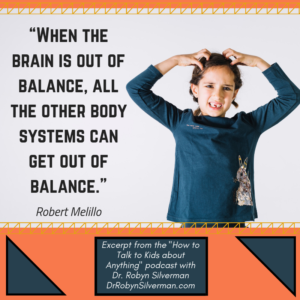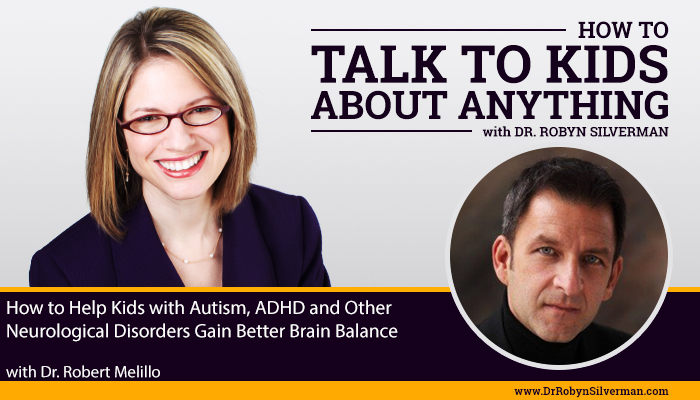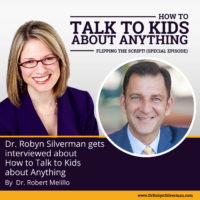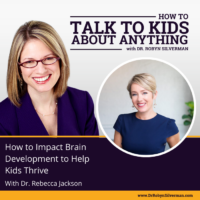Podcast: Play in new window | Download
Subscribe: Apple Podcasts | RSS | More
How to Help Kids with Autism, ADHD and Other Neurological Disorders Gain Better Brain Balance
This podcast will focus on functional disconnection associated with common childhood neurological disorders and diagnoses such as ADHD, Autism Spectrum Disorder, Tourette Syndrome, Dyslexia and more. Why have these diagnoses become more prevalent? What are the signs of Functional Disconnection? And how can we help kids to gain greater brain balance that can help them thrive academically, socially and emotionally? We turn to Dr. Robert Melillo for these answers.
There is no question- there has been a marked increase in children diagnosed with autism spectrum disorder, ADHD, dyslexia, Tourette Syndrome, and other neurological disorders. We have also heard of increases in food sensitivities, social problems, screen usage and medication use and a decrease in getting out into nature, going out for recess and unstructured play. Are these things connected? And if so, what can we do about it all? To answer these questions and more, we are turning to Dr. Robert Melillo.
Dr. Robert Melillo is a world-renowned chiropractic neurologist, professor and researcher in child neurological disorders, and creator of the Brain Balance Program. Since 1994, his program has helped thousands of children with autism spectrum disorder, ADHD, dyslexia, Tourette Syndrome, and other disorders. His Brain Balance Achievement Centers are located throughout the United States. He is the author of Disconnected Kids, Disconnected Kids, Reconnected Families, Reconnected Kids and more. You can learn more about Dr. Melillo and his work at DrRobertMelillo.com
The podcast provides:
- Reasons for the rise in many childhood neurological disorders
- A discussion of functional disconnection and what several of the childhood neurological disorders have in common
- The signs and symptoms of functional disconnection
- Tips to help kids with functional disconnection that is related to these popular childhood neurological disorders
- Challenges and benefits to changing children’s habits and diet
- Specific exercises that can help children with these common neurological disorders to thrive
Important Messages:
- There is not an over-diagnosis— but rather, under-reporting of autism and ADHD. Yes, we recognize it more and we have
 better tests but there still is a huge rise in neuro-diagnoses.
better tests but there still is a huge rise in neuro-diagnoses. - Co-morbidity- many of these children who are diagnosed with ADHD or autism have more than one diagnoses. They are the same problem that are manifesting differently in the brain.
- The neuro-issues that kids are having is not related to damage in the brain. It’s an issue of functional disconnection- the way the brain communicates.
- Different networks in the brain must resonate with one another- if it’s thrown off, it throws off how we are able to learn socially, academically or behaviorally. This is what functional disconnection is all about.
- The right side of the brain develops predominantly in the first two years, then the left brain takes over the dominant growth, and they go back and forth from there. Both are growing— but one side of the brain is developing 20% more than another at any given time.
- When something interferes, one side of the brain may slow down in development and the other side of the brain may kick in too early. This can create an unevenness of skills.
- What’s going on with ADHD—> hyperactive on one side, other side underdeveloped. Skills are not on par with age group. Attention problem- right brain function is under-developed. Dorsal attention network. Then we simultaneously see hyperactivity, increased motor activity, impulsivity, obsessive compulsive behavior- left brain function. Too much left brain activity, under-activity on the right side.
- There’s an unevenness of skills- gifted in one area and immature in others.
- Studies show that children with ADHD have immature or underdeveloped networks in their brains. Because one side slows down, the other side speeds up. The imbalance prevents the children with these neuro issues to use their whole brain.
- These kids can be many years ahead in many skills while at the same time many years behind in other skills. This is functional imbalance that prevents children from using their whole brain at the same time.
- Kids and using big muscles- makes a huge difference in the way the brain works.
- Coordination and timing that we build up in our bodies to walk and run are the same timing mechanisms we use to coordinate networks on either side of the brain. Many have motor milestone delays- rolling over, crawling problems, delayed walking. If they’re late in walking, they’ll be late in talking.
- Movement and cognition- and relationship- so important. Most of the time when they have delays in movement it’s because of retained primitive reflexes.
- We are born with reflexes so we can survive. They go away in the first 6 months of a year- then allow for our brain to mature. If kids don’t get rid of these reflexes, it delays growth. When we get rid of these reflexes, it allows the brain to catch up.
- The good news is that because there is no genetic mutation or damage- there is nothing preventing us from preventing this issue. We need to focus on the underdeveloped areas of the brain. we must modify the environment like nutrition and exercise. Also, light, sounds, rhythmic movement— targeting the underdeveloped parts of the brain. We measure the growth to move them up developmentally.
 Parents, as soon as there is dead air or boredom, they immediately put a phone in their toddler’s hands. It’s like using a drug to sedate them.
Parents, as soon as there is dead air or boredom, they immediately put a phone in their toddler’s hands. It’s like using a drug to sedate them.- We can be creating an imbalance in the brain with too much tech— especially in the first 6 years of life when they 2 hemispheres are forming. Tech stimulates the left brain—which can lead to overdevelopment in this area and underdevelopment in the right half. Then you see right brain deficiencies- ADHD, Autism, Tourettes, OCD, and even psychosis, Schizophrenia. Also drug addiction.
- It can be like talking to a drug addict when you need to change the amount of tech and a certain diet.
- A lot of rage and anxiety we see can be traced to lack of structure— it’s like saying “there’s no parent at home here.” They know they should be regulated- but nobody is telling them any different.
- Engage the big muscles! Exercise and dietary changes are extremely helpful. Heart rate variability changes the brain more rapidly than anything else.
- Food sensitivities- digestive issues- when the brain is out of balance all systems can get out of balance.
- Play tag with the kids! Ride bikes! Get heart rate moving and strengthen the muscles., Pull up bar. Fun, gets kids away from video games. Calms down the fight or flight system so that digestive system and immune system will work better.
- We have to remember that learning is about the brain.
- Schools are overwhelmed. We need to correct these issues outside of the school system.
- Move, increase strength- that will have a big impact.
Notable Quotables:
 “The neurological disorders are about functional connectivity in the brain. There isn’t any injury or damage- it’s not a chemical problem, inflammation or pathology or genetic mutation. It’s about how the brain communicates. It’s the way the brain functions and connects and synchronizes— how networks speak to one another, especially on different sides of the brain. When there is a problem that interferes with that, certain parts of the brain resonate better than others. It’s all about resonance.”
“The neurological disorders are about functional connectivity in the brain. There isn’t any injury or damage- it’s not a chemical problem, inflammation or pathology or genetic mutation. It’s about how the brain communicates. It’s the way the brain functions and connects and synchronizes— how networks speak to one another, especially on different sides of the brain. When there is a problem that interferes with that, certain parts of the brain resonate better than others. It’s all about resonance.”- What’s ADHD? On the one side, you have an attention problem which is a right brain function that is under-developed. Simultaneously, we see hyperactivity, increased motor activity, impulsivity and obsessive compulsive behavior- left brain functions that show too much left brain activity and under-activity on the right side. We combine these two things together and we get ADHD. There’s a developmental imbalance or developmental asynchrony where one side of the brain or certain networks are growing and maturing at a different rate than others.
- “Some children with neurological issues like ADHD or Autism Spectrum Disorder are 4, 5, 6, 7, 8, years ahead in certain skills but yet 4, 5, 6, behind in other skills. The functional imbalance is the problem. It’s the disability. The maturity imbalance prevents the brain networks from being able to resonate with one another and combine the information so the child can use his whole brain at the same time.”
- “Movement is what develops the brain so if children aren’t moving, it’s going to affect their brains!”
- “Motor milestones matter.”
- “Many parents, as soon as there is dead air or boredom, immediately put a phone in their toddler’s hands. It’s like using a drug to sedate them.”
- “Kids want parents they are going to respect. They want structure. They like it. It makes them feel safe.”
- “We need to set up rules— with the child- and then you have to set up consequences. And then you just play by those rules.”
- “When the brain is out of balance, all the other body systems can get out of balance.”
- “We have to remember that learning is about the brain. Everything we do should be focused on what is going to be best for the developing brain at different stages.”
- “Movement is the main thing that drives brain activity.”









